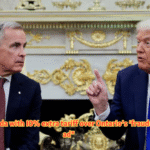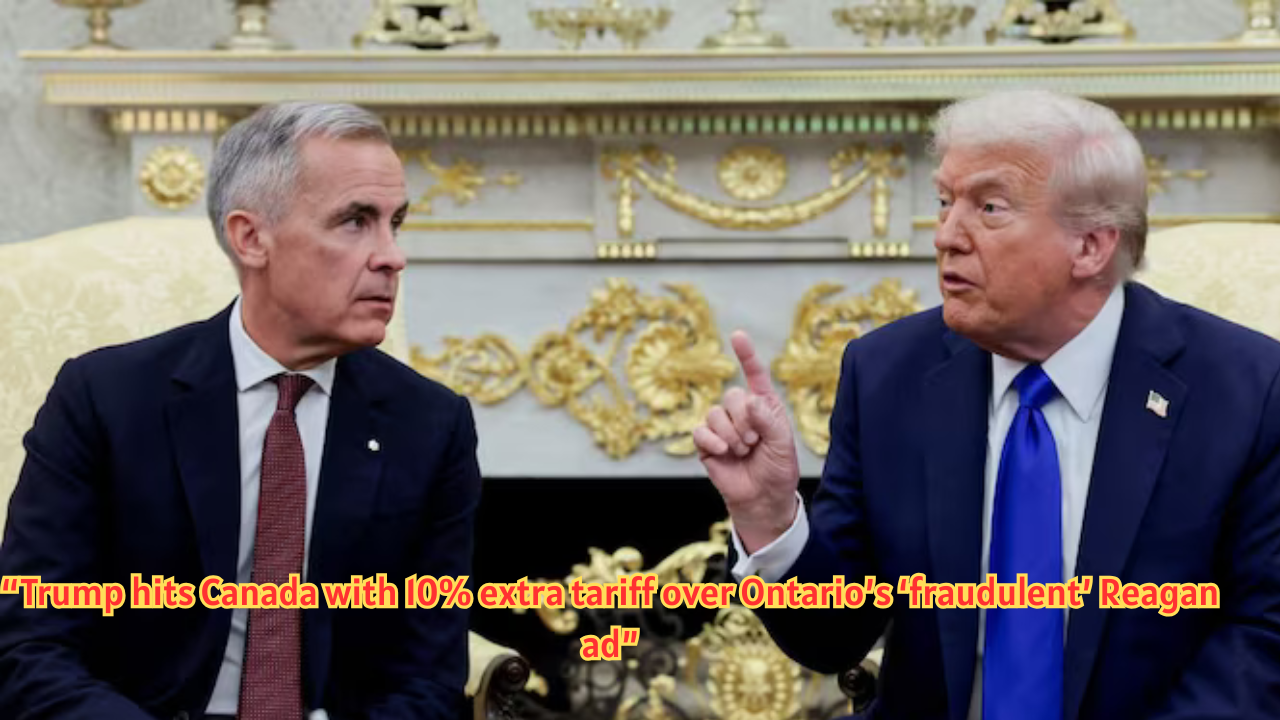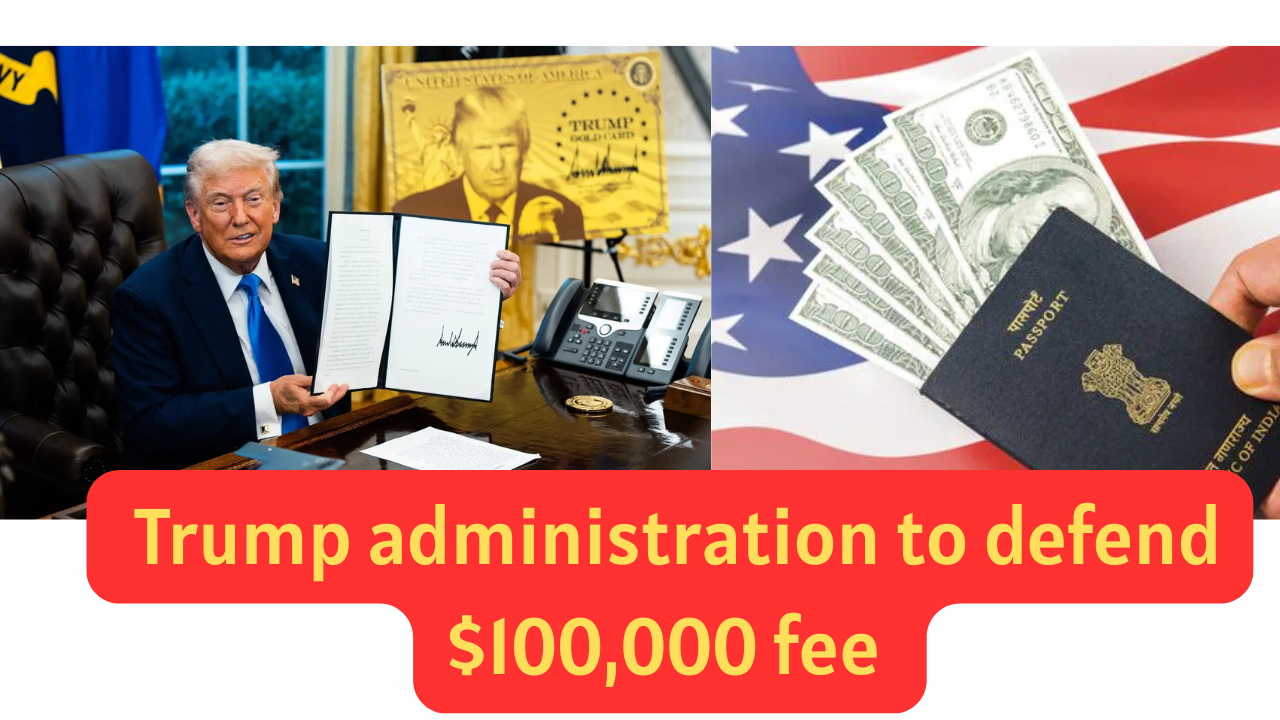In late October 2025, a new flashpoint erupted in the long-running trade dispute between the United States and Canada. U.S. President Donald Trump announced that he would impose an additional 10 per cent tariff on Canadian imports, citing what he called a “fraudulent” advertisement created by the Canadian province of Ontario that used snippets of former U.S. President Ronald Reagan in an anti-tariff message. The move marks a sharp escalation in U.S. trade policy and underscores how media, politics and trade policy are increasingly intertwined.

Background: U.S.–Canada trade tensions
The trade relationship between Canada and the U.S. has been strained for years, but under Trump’s second administration it entered a more volatile phase. As part of a broader protectionist agenda, Trump used tariff threats and actual tariffs to challenge what he sees as unfair trade practices by close allies. Canada, historically the U.S.’s largest trading partner, has felt the pressure.
Earlier in 2025, the U.S. imposed high tariffs on Canadian goods, including 25 % on many imports and 10 % on energy products in the initial phase. Canadian retaliatory tariffs followed, and trade dialogues intermittently broke down. These tensions laid the groundwork for what happened in October.
The Ontario advertisement: what it was and why it mattered
On or around 23 October 2025, the provincial government of Ontario, led by Premier Doug Ford, launched an anti-tariff advertising campaign aimed at American audiences. The ad aired during the Major League Baseball World Series broadcast, featuring the Toronto Blue Jays vs. Los Angeles Dodgers, giving it a high-visibility platform.
The advertisement used edited audio and video of Ronald Reagan’s 1987 speech warning that high tariffs — and the resulting retaliation by foreign countries — would hurt American workers and lead to trade wars.According to the Ronald Reagan Presidential Foundation & Institute, this usage was unauthorised and misrepresented his remarks. The foundation claimed Ontario used “selective audio and video” without permission and may take legal action.
Ford defended the campaign as intended to spark American-Canadian dialogue around how tariffs affect workers and businesses. But to President Trump, the ad crossed a line: he labelled it a “hostile act” and demanded its immediate removal.
Trump’s reaction and the tariff announcement
On 25 October 2025, Trump announced via his Truth Social platform that he was increasing tariffs on Canada by 10 % “above what they’re paying now”, citing the Ontario ad. He framed it as a response to misrepresentation of facts and an “act of hostility”
He wrote:
“Their Advertisement was to be taken down, IMMEDIATELY, but they let it run last night … knowing that it was a FRAUD.”
He also suspended trade talks with Canada until the issue is resolved.
It is not yet fully clear which categories of Canadian imports will be subject to this additional tariff or how broadly it will apply, though he emphasised that the hike comes on top of existing tariffs.
Canada’s response and internal dynamics
On the Canadian side, Prime Minister Mark Carney expressed readiness to resume trade talks but emphasised that trade policy is a federal matter and should be handled at the national level.
Premier Doug Ford, following discussions with Carney, announced that the ad campaign would be paused starting Monday, 27 October, in order to open the path for negotiation. However, he allowed the ad to continue running for the weekend (including during the World Series game), which appears to have deepened Trump’s frustration.

Within Canada, the incident exposed tensions between provincial-federal authority and differing approaches to dealing with Washington. While Ontario opted for a bold and public campaign, Ottawa prefers more diplomatic channels.
Why this matters: trade, image and politics
The episode combines multiple dimensions:
1. Trade substance: The additional 10 % tariff escalation adds further strain to an already fraught bilateral trade relationship. For Canada, whose economy relies heavily on exports to the U.S., any new tariff threatens industries, workers and jobs. For the U.S., such moves signal a willingness to use trade policy aggressively even against friendly nations.
2. Media and narrative: The controversy was ignited not by traditional trade data or negotiations but by a media campaign: an ad. That underscores how trade conflicts are increasingly intertwined with political messaging, reputation and public diplomacy.
3. Historical symbolism: By invoking Ronald Reagan — a Republican icon known for free-market rhetoric but also complex trade views — Ontario attempted to appeal to U.S. conservative audiences. But the mis-use of his legacy triggered backlash. The legal and moral question of using someone’s speech without permission became central.
4. Political optics: For Trump, the ad provided a convenient trigger to assert tough posture: charging Canada with “fraud” and “hostile act” gave him rhetorical justification for escalating tariffs. For Ford, the high visibility of the campaign may have been a gamble to draw attention to Canada’s trade grievances, but it also drew direct confrontation. For Carney and the Canadian federal government, the challenge is balancing defence of Canadian interests with the risk of alienating the U.S.
5. Global context: The U.S.-Canada dispute plays out in a broader global trade environment where protectionism and tariff wars are resurfacing. For other countries, the episode sends a reminder that trade disputes can escalate rapidly, even between longstanding allies.
What happens next? Potential consequences and scenarios
Short-term:
- The immediate question is whether the U.S. will enact the additional 10 % tariff universally or selectively. The lack of clarity increases market and business uncertainty.
- Canadian exports may face increased costs, reducing competitiveness in the U.S. market and possibly leading to job losses or price hikes.
- Trade talks between Ottawa and Washington are on hold. Until they resume, escalation remains a risk.

Medium-term:
- Canada may seek to diversify its export markets or strengthen trade with other partners, including via free-trade agreements or regional blocs.
- Political pressure within Canada may mount on provincial and federal leaders to coordinate strategy and avoid unilateral provocations.
- Legal and reputational fallout: the Reagan Foundation’s statement that they did not authorise the ad raises potential legal claims and may shape how future trade-related advertising campaigns are handled.
Long-term:
- The incident could reshape the architecture of the U.S.–Canada trade relationship. If tariffs become more permanent for certain sectors, Canadian firms may relocate or restructure supply chains.
- For the U.S., the move signals that even friendly countries can be treated as trade adversaries if political messaging triggers it — which could have broader diplomatic implications.
- It may deepen Canadian public sentiment that their neighbouring superpower is acting unpredictably, potentially fuelling shifts in domestic Canadian politics or public-opinion attitudes toward the U.S.
Critiques and counter-arguments
Some analysts argue that the Ontario ad “backfired”. While intended to appeal to Americans and highlight the burdens of U.S.-imposed tariffs, the ad inadvertently allowed Trump to cast Canada as the aggressor and justify tariff escalation. Others contend that using Reagan’s speech in a politically charged advertisement, without clear permission or context, was an unnecessary provocation.
On the U.S. side, critics of Trump’s approach argue that imposing tariffs on a close ally in retaliation for an ad sets a dangerous precedent: trade policy becomes reactive to media messaging rather than grounded in economic fundamentals. For Canadian industries, the timing is challenging: many sectors are already dealing with previous tariff burdens and supply-chain disruptions.
The human and business sides
Beyond diplomatic posturing, the escalation has real consequences. Canadian exporters — especially in sectors like steel, aluminium, automotive components, lumber and agri-food — may face higher U.S. tariffs, which will squeeze margins, reduce exports or force relocation. For U.S. consumers and businesses that import Canadian inputs, higher costs may translate into higher prices or disrupted supply chains. The elevated risk may also deter investment decisions in cross-border manufacturing.
Moreover, the public dimension — the ad airing during the World Series — shows how trade disputes are no longer confined to boardrooms or negotiation tables. They play out in living rooms, on TV screens, in public opinion. For workers in border regions, for businesses reliant on cross-border supply links, the stakes are real.
What this reveals about Trump’s trade philosophy
This episode provides a window into President Trump’s trade playbook:
- He views tariffs not just as economic tools but as instruments of political signalling.
- He appears willing to escalate rapidly when he perceives a diplomatic or reputational challenge, even with a friendly nation.
- Messaging matters: calling the ad a “fraudulent hostile act” framed the trade move not purely as economics, but as moral and political retaliation.
- He leverages social-media (Truth Social) to announce policy shifts, bypassing traditional bureaucratic channels.
What it reveals about Canada’s strategy — and the risks
Ontario’s launch of the ad campaign reflects a more aggressive strategy: using public-campaign tactics to draw American attention to Canadian grievances. But this carries risk. While raising awareness, the campaign triggered a sharp U.S. response, potentially worsening the trade climate. At the national level, Canada must walk a fine line: defending its exporters while maintaining a viable relationship with its largest market. The provincial-federal tension adds complexity.
Conclusion
The 10 % tariff that President Trump has slapped on Canada in response to Ontario’s “fraudulent” Reagan ad signifies more than just another skirmish in the U.S.–Canada trade saga






